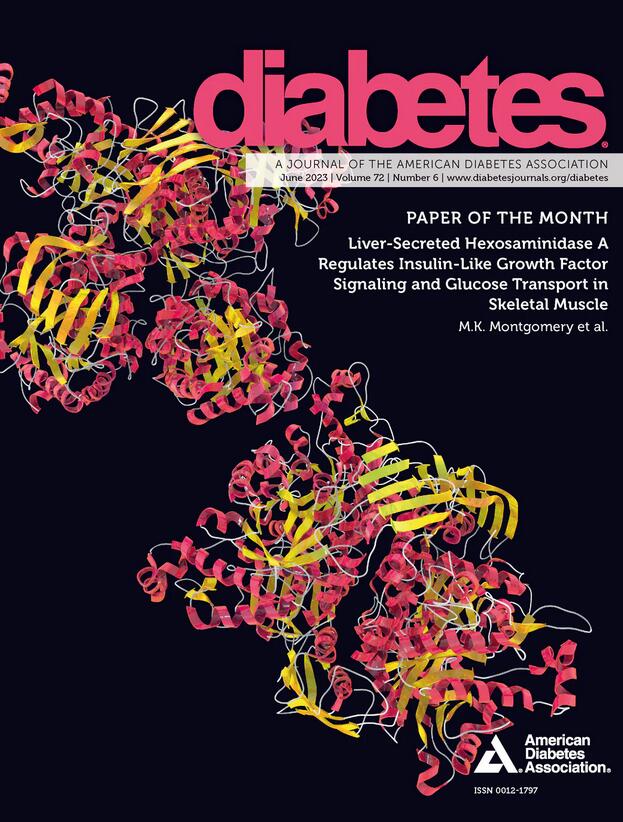1756-P: Metabolic Bariatric Surgery Effects on Skeletal Muscles and Adipose Tissues
IF 7.5
1区 医学
Q1 ENDOCRINOLOGY & METABOLISM
引用次数: 0
Abstract
Introduction and Objective: Visceral adipose tissue and skeletal muscles play a key role in the onset of Metabolic Syndrome and Atherosclerotic Diseases. To understand their changes after Metabolic Bariatric Surgery (MBS) we performed a 10 years follow up of the FLORINASH cohort. Methods: Results were obtained on 44 obese subjects: 23 underwent to lifestyle changes and 21 to MBS with 5 years as time since surgery for 7 patients and 10 years for 14 patients. All patients underwent abdominal CT scan: subcutaneous and visceral adipose tissue volumes were measured between D12 vertebra and femoral heads. Areas of skeletal muscle tissue (SMT), subcutaneous (SAT) and visceral adipose tissue (VAT) were calculated on a slice passing through the L3 vertebra. Results: A significant reduction in VAT and SMT were found in post-bariatric patients, while there weren't differences in SAT and total adipose tissue (TAT) volume. Dividing patients on the basis of time since surgery, we observed that those operated since 5 years showed a greater reduction in VAT compared to 10 years post-surgery patients, while the last had enhanced sarcopenia. VAT and TAT were significantly correlated with weight, BMI, waist circumference, adiposity evaluation by BIA and DEXA, but not with metabolic parameters. SM area was correlated with hand grip strength (p=0,011). VAT area was not associated with age but significantly correlates with BMI (p=0,003), waist (p<0,001), body weight (p=0,013), adipose tissue (BIA: % Fat mass p<0,001, kg Fat mass p<0,001, DEXA: Fat p<0,001). VAT correlates with components of metabolic syndrome such as glycemia (p=0.007), insulinemia (p=0.001), triglycerides (p=0.039), HBA1c (p<0.001), insulin resistance (HOMA p=0.002), intima-media thickness (p=0.007) and degree of hepatic steatosis (p<0.001). Conclusion: The exactly measure VAT and SM by CT scan slice might contribute to really understand and predict the cardiometabolic risk of overweight or obese patients and could be performed simply and routinely. Disclosure M. Cardellini: None. D. Morosetti: None. V. Spinozzi: None. F. Davato: None. P. Gentileschi: None. A. Carini: None. F. Garaci: None. R. Menghini: None. M. Federici: None.1756-P:代谢减肥手术对骨骼肌和脂肪组织的影响
简介与目的:内脏脂肪组织和骨骼肌在代谢综合征和动脉粥样硬化性疾病的发病中起关键作用。为了了解他们在代谢减肥手术(MBS)后的变化,我们对FLORINASH队列进行了10年的随访。方法:对44例肥胖患者进行分析,其中生活方式改变23例,MBS 21例,术后5年7例,术后10年14例。所有患者均行腹部CT扫描:测量D12椎体和股骨头之间的皮下和内脏脂肪组织体积。在穿过L3椎体的切片上计算骨骼肌组织(SMT)、皮下组织(SAT)和内脏脂肪组织(VAT)的面积。结果:肥胖后患者的VAT和SMT显著降低,而SAT和总脂肪组织(TAT)体积无差异。根据手术后的时间对患者进行划分,我们观察到手术后5年的患者VAT比手术后10年的患者减少得更多,而手术后10年的患者肌肉减少症增加。VAT和TAT与体重、BMI、腰围、BIA和DEXA肥胖评价有显著相关,与代谢参数无显著相关。SM面积与握力相关(p= 0.011)。VAT面积与年龄无关,但与BMI (p= 0.003)、腰围(p= 0.003)、体重(p= 0.013)、脂肪组织(BIA: % Fat mass p< 001, kg Fat mass p< 001, DEXA: Fat p< 001)显著相关。VAT与代谢综合征的组成部分相关,如血糖(p=0.007)、胰岛素血症(p=0.001)、甘油三酯(p=0.039)、HBA1c (p=0.001)、胰岛素抵抗(HOMA p=0.002)、内膜-中膜厚度(p=0.007)和肝脂肪变性程度(p=0.001)。结论:通过CT扫描片准确测量VAT和SM有助于真正了解和预测超重或肥胖患者的心脏代谢风险,可以简单、常规地进行。卡德利尼:没有。D. Morosetti:没有。斯宾诺齐:没有。F. Davato:没有。P. Gentileschi:没有。A. Carini:没有。F. Garaci:没有。R. Menghini:没有。M. Federici:没有。
本文章由计算机程序翻译,如有差异,请以英文原文为准。
求助全文
约1分钟内获得全文
求助全文
来源期刊

Diabetes
医学-内分泌学与代谢
CiteScore
12.50
自引率
2.60%
发文量
1968
审稿时长
1 months
期刊介绍:
Diabetes is a scientific journal that publishes original research exploring the physiological and pathophysiological aspects of diabetes mellitus. We encourage submissions of manuscripts pertaining to laboratory, animal, or human research, covering a wide range of topics. Our primary focus is on investigative reports investigating various aspects such as the development and progression of diabetes, along with its associated complications. We also welcome studies delving into normal and pathological pancreatic islet function and intermediary metabolism, as well as exploring the mechanisms of drug and hormone action from a pharmacological perspective. Additionally, we encourage submissions that delve into the biochemical and molecular aspects of both normal and abnormal biological processes.
However, it is important to note that we do not publish studies relating to diabetes education or the application of accepted therapeutic and diagnostic approaches to patients with diabetes mellitus. Our aim is to provide a platform for research that contributes to advancing our understanding of the underlying mechanisms and processes of diabetes.
 求助内容:
求助内容: 应助结果提醒方式:
应助结果提醒方式:


